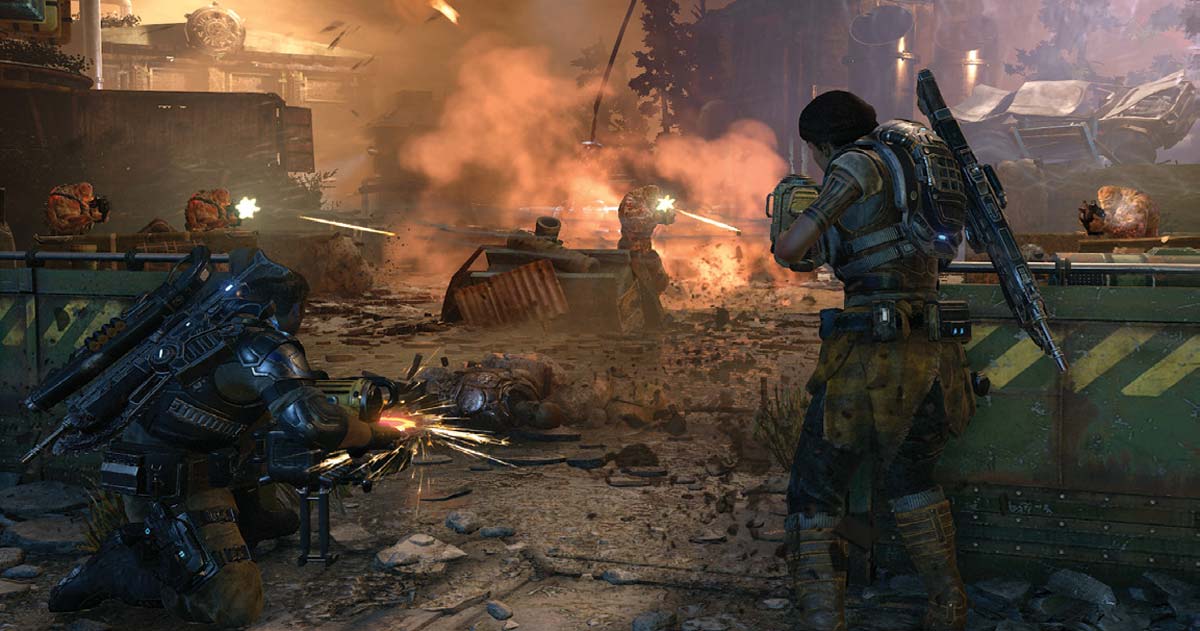By ANDY EDDY
The videogame industry has taken some incredible strides in a relatively short period of time. In the late ’80s, when Nintendo became a household name around America for its Nintendo Entertainment System (NES), and with such notable game releases as Super Mario Bros., games were mostly 2D, sprite-based “side scrollers,” perhaps creating pseudo-3D with parallax variations between background “layers.” Now, just 30 years later, we have PlayStation 4, Xbox One and PC entertainment software with full 3D presentation of realistic characters, intricate architecture and rich worlds.
Take Gears of War 4, the fifth entry in the hyperviolent, third-person-shooter franchise. This latest installment was released October 11, 2016, for Windows PCs and the Xbox One console. The GoW series – which has shipped over 26 million copies worldwide – is known for its diverse pacing, from lengthy set pieces with snappy dialogue and character interplay that build a rich story, to frantic combat with big, highly detailed character models and giant weapons. The signature weapon in the game series is the Lancer assault rifle with the chainsaw bayonet attachment, which leaves little to the imagination in its level of destructive power and grisly results, but there are numerous arms available, from sniper rifles to shotguns to an explosive launching gun called Dropshot.
“Whatever we think we need that’s going to make the artists’ lives easier or automate repeated tasks, they’re very responsive. We want our artists to be artists. We don’t need them to be fighting with their computers.”
—Aryan Hanbeck, Associate Art Director, The Coalition
RISE LIKE A FENIX
The GoW4 story focuses on JD Fenix – the son of Marcus Fenix, the lead protagonist in the original GoW trilogy – and his squadmates, Kait and Del, as they battle on the planet Sera against numerous enemies. The trio will need to find and rescue their missing family members, but also discover the source of a new enemy race, the Swarm, which threatens the human race.
GoW4 is the first new GoW title on Microsoft’s latest and most advanced game console, Xbox One, and the product review from game-reporting website Polygon said, “It’s easily the best-looking game on Xbox One.” It had been nominated for Best Action Game and Best Multiplayer awards at The Game Awards 2016, and it earned a nomination for Outstanding Visual Effects in a Real-time Project at the 15th annual VES Awards.
Another change with GoW4 was that it was the first Gears game not to be developed by North Carolina-based Epic Games, which launched the series with the first game in 2006. This game’s development was handled by The Coalition, a seven-year-old, Vancouver-based studio owned by Microsoft (which bought the GoW franchise from Epic after the original trilogy). The Coalition operated under other names earlier, including Zipline Studios, Microsoft Studios Vancouver and Black Tusk Studios. The Coalition name, though, ties it to the Gears universe, with the series featuring a faction called the Coalition of Ordered Governments (or “COG”). It’s clear that Coalition’s focus will be on Gears games.
START YOUR ENGINE
Gears titles have always been a graphics tours de force, but Gears of War 4 takes the visuals to a new level, thanks to the robust hardware platforms on which it plays. A large part of the game’s visual authority comes from its foundation: It was constructed in Epic’s Unreal Engine 4. The development suite was first introduced in 1998, but the latest version – which is also free, with royalties paid only when the developed product is sold – is polished and powerful, with plenty of advanced tools and tech available out of the box. However, it’s also open to modification for custom procedures and effects. Unreal Engine helped The Coalition art team meet its goal of making GoW4 into what Associate Art Director Aryan Hanbeck called “the most visually inspiring game of 2016.”
“We had a really good working relationship with Epic, and Epic would help us out any time we could use some help – they were a great partner,” says Colin Penty, CG supervisor on GoW4. “We, of course, did some modifications here and there to streamline things or make things work better on Xbox One.”
“[Unreal is an] awesome engine and it’s very feature complete – though we do a lot of work on it, and we have a good tools and engine team that really support us, so as we go forward, whatever we think we need that’s going to make the artists’ lives easier or automate repeated tasks, they’re very responsive,” Hanbeck adds. “We want our artists to be artists. We don’t need them to be fighting with their computers.”
Of course, there were other tools that Coalition artists put to use in their work. Penty says, “We’re a Maya house…PhotoShop, Substance Painter…all on Windows workstations. We use pretty beefy workstations to handle our levels in Unreal 4. We had such massive levels with so much content in them – like a 100,000 assets inside a level – so we had to upgrade our hardware a few times throughout the production to keep up with our density.”
“We had a really good working relationship with Epic, and Epic would help us out any time we could use some help — they were a great partner. We, of course, did some modifications here and there to streamline things or make things work better on Xbox One.”
— Colin Penty, CG Supervisor on GoW4
The art team faced numerous other challenges across the 30-month project, one of which was maintaining a self-imposed high frame rate across all gameplay modes: The single-player campaign runs at 30fps in 1080p, while the multiplayer modes run at 60fps in 1080p. There was also the matter of releasing a beta for the purpose of seeing how the gameplay was received, and getting subsequent comments from the players that could be used in the remaining months to make the game’s elements better. The beta came out with graphics that weren’t close to release-candidate quality, but there was still some great feedback from the community on how specific effects could be improved.
“We released a beta, and it was clear that the community wasn’t happy with the blood…which was like ‘Oh, no…that’s horrible.’ This is one of the pillars. I want to get the blood right first,” says Stu Maxwell, the game’s lead creatures and weapons artist. “Of course, it’s a work in progress…we did a true beta where we were really testing the game before we polished all of the art. Hey, that happens, but it just meant that I went back to the drawing board and really figured out how to take our blood to the absolute industry top, which was our goal.”
A PLOT TWISTER
When the three artists interviewed were asked how The Coalition pushed the envelope, all of them cited the game’s “windflares.” The effect starts as a tornado-like windstorm that picks up and throws everything that isn’t nailed down – plants and trees, debris, dead bodies. The wind is also strong enough to affect your projectile weapons, sending bullets in unintended directions – perhaps back at you.
“We released a beta, and it was clear that the community wasn’t happy with the blood…which was like ‘Oh, no…that’s horrible.’ This is one of the pillars. I want to get the blood right first. Of course, it’s a work in progress…we did a true beta where we were really testing the game before we polished all of the art. Hey, that happens, but it just meant that I went back to the drawing board and really figured out how to take our blood to the absolute industry top, which was our goal.”
— Stu Maxwell, GoW4’s lead creatures and weapons artist
The windflare can also generate “lightning flurries” that send multiple bolts of lightning at the ground. These bolts move across the terrain and break into more bolts. The bolts may take out some of the enemies you’re trying to defeat, so it can be a helpful offensive “weapon,” but you have to be careful that you don’t end up becoming a victim of the dangerous electricity yourself. You can take shelter from the windflare, but it won’t help you progress very much in your pursuit of moving along into the game. The windflares are massive, world-changing events, but also visually effective, presenting an ominous enemy to your team – and untraditional because it’s not on two legs and doesn’t carry a gun.
“It’s like you walk right into the center of an alternative-reality tornado. A tornado that isn’t just wind, but now it’s wind and lightning…extreme winds that are almost like fantasy – and what that entailed is creating the feeling of being in the most destructive possible environment,” Maxwell says. “Filling the air with debris, huge storm walls in the distance with inner lightning and lightning coming into the field destroying cover objects it happens to hit. I don’t know if I’ve ever seen a level in a game that has that level of intensity and complexity.”
“Of course, there were other tools that Coalition artists put to use in their work. We’re a Maya house… PhotoShop, Substance Painter… all on Windows workstations. We use pretty beefy workstations to handle our levels in Unreal 4. We had such massive levels with so much content in them – like a 100,000 assets inside a level – so we had to upgrade our hardware a few times throughout the production to keep up with our density.”
—Colin Penty
“There are four or five points where you get hit by a…massive hurricane-like storm,” Penty adds. “Those are the points where everyone would have to come together, but especially the visual effects team, to create something that was all-encompassing, that would fill a run at 30fps at 1080p in Xbox One. When we pulled them off, they were the points where we really demonstrated what we could do with the hardware.”
The windflares ended up being quite impressive, but without question they were graphics components that needed a number of iterations before they truly became the showcases the art team sought them to be.
“The windflares have lots of elements to them – it’s the way the storm looks, how it approaches, what the lightning orbs look like, how it affects gameplay,” Hanbeck says. “So from a purely visual standpoint, we built that windflare maybe four or five times from bottom up…and we’d kill it and play it and look at it. We’d look at it for a few weeks and say, ‘You know what? This isn’t good enough… it doesn’t look right, it’s not impressive enough, it’s not blowing the socks off anyone.’ This is one of our visual pillars here, so it has to look good. So, we’d revisit it…we’d cut right back down to concept phase, reconcept it out with a different take and try it again.”
READING, ’RITING, ’RITHMETIC…AND RENDERING
As far as the game industry has come – with Gears of War 4 as proof of what its current labor force and consumer-available hardware can provide to players in the way of visual fidelity and presentation – there’s still a lot that can be done to improve the standards and push the envelope.
“When I went to school, there was no concept of a game VFX artist,” Maxwell explains. “Certainly, there were specialty schools at the time that had a little bit of film VFX work…there wasn’t even a game-design school, but now that does exist – and there’s plenty of them. Thankfully the new generation is growing up learning how to become game designers, but still VFX is so specialized that there’s a limited amount of VFX education out there.”
And I guess we’ll see how much things have changed when The Coalition and parent Microsoft are ready to bring Gears of War 5 to store shelves.








